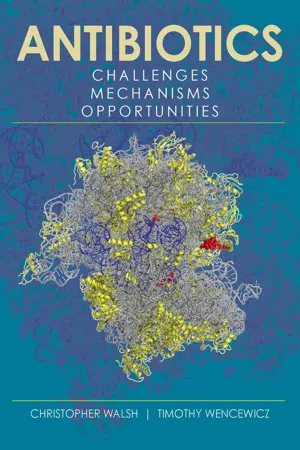Abouhamad WN, Manson M, Gibson MM, Higgins CF. 1991. Peptide transport and chemotaxis in Escherichia coli and Salmonella typhimurium: characterization of the dipeptide permease (Dpp) and the dipeptide-binding protein. Mol Microbiol 5:1035–1047.[PubMed][CrossRef]
Abraham EP. 1987. Cephalosporins 1945–1986. Drugs 34(Suppl 2):1–14.[PubMed][CrossRef]
Acebron I, Chang M, Mobashery S, Hermoso JA. 2015. The allosteric site for the nascent cell wall in penicillin-binding protein 2a: an Achilles’ heel of methicillin-resistant Staphylococcus aureus. Curr Med Chem 22:1678–1686.[PubMed][CrossRef]
Achari A, Somers DO, Champness JN, Bryant PK, Rosemond J, Stammers DK. 1997. Crystal structure of the anti-bacterial sulfonamide drug target dihydropteroate synthase. Nat Struct Biol 4:490–497.[PubMed][CrossRef]
Ackermann G, Rodloff AC. 2003. Drugs of the 21st century: telithromycin (HMR 3647)—the first ketolide. J Antimicrob Chemother 51:497–511.[PubMed][CrossRef]
Adams DW, Errington J. 2009. Bacterial cell division: assembly, maintenance and disassembly of the Z ring. Nat Rev Microbiol 7:642–653.[PubMed][CrossRef]
Adnan S, Paterson DL, Lipman J, Roberts JA. 2013. Ampicillin/sulbactam: its potential use in treating infections in critically ill patients. Int J Antimicrob Agents 42:384–389.[PubMed][CrossRef]
Alexeeva S, Gadella TW Jr, Verheul J, Verhoeven GS, den Blaauwen T. 2010. Direct interactions of early and late assembling division proteins in Escherichia coli cells resolved by FRET. Mol Microbiol 77:384–398.[PubMed][CrossRef]
Allington DR, Rivey MP. 2001. Quinupristin/dalfopristin: a therapeutic review. Clin Ther 23:24–44.[PubMed][CrossRef]
American Chemical Society. 1999. Discovery and development of penicillin: international historic chemical landmark. American Chemical Society, Washington, DC. http://www.acs.org/content/acs/en/education/whatischemistry/landmarks/flemingpenicillin.html.
Anderson RJ, Groundwater PW, Todd A, Worsley AJ. 2012. Antibacterial Agents: Chemistry, Mode of Action, Mechanisms of Resistance and Clinical Applications. John Wiley & Sons, Ltd, Chichester, United Kingdom.
Andries K, Verhasselt P, Guillemont J, Gohlmann HW, Neefs JM, Winkler H, Van Gestel J, Timmerman P, Zhu M, Lee E, Williams P, de Chaffoy D, Huitric E, Hoffner S, Cambau E, Truffot-Pernot C, Lounis N, Jarlier V. 2005. A diarylquinoline drug active on the ATP synthase of Mycobacterium tuberculosis. Science 307:223–227.[PubMed][CrossRef]
Andriole VT. 2005. The quinolones: past, present, and future. Clin Infect Dis 41(Suppl 2):S113–S119.[PubMed][CrossRef]
Angehrn P, Goetschi E, Gmuender H, Hebeisen P, Hennig M, Kuhn B, Luebbers T, Reindl P, Ricklin F, Schmitt-Hoffmann A. 2011. A new DNA gyrase inhibitor subclass of the cyclothialidine family based on a bicyclic dilactam-lactone scaffold. Synthesis and antibacterial properties. J Med Chem 54:2207–2224.[PubMed][CrossRef]
Arias CA, Murray BE. 2015. A new antibiotic and the evolution of resistance. N Engl J Med 372:1168–1170.[PubMed][CrossRef]
Arnison PG, Bibb MJ, Bierbaum G, Bowers AA, Bugni TS, Bulaj G, Camarero JA, Campopiano DJ, Challis GL, Clardy J, Cotter PD, Craik DJ, Dawson M, Dittmann E, Donadio S, Dorrestein PC, Entian KD, Fischbach MA, Garavelli JS, Göransson U, Gruber CW, Haft DH, Hemscheidt TK, Hertweck C, Hill C, Horswill AR, Jaspars M, Kelly WL, Klinman JP, Kuipers OP, Link AJ, Liu W, Marahiel MA, Mitchell DA, Moll GN, Moore BS, Müller R, Nair SK, Nes IF, Norris GE, Olivera BM, Onaka H, Patchett ML, Piel J, Reaney MJ, Rebuffat S, Ross RP, Sahl HG, Schmidt EW, Selsted ME, Severinov K, Shen B, Sivonen K, Smith L, Stein T, Süssmuth RD, Tagg JR, Tang GL, Truman AW, Vederas JC, Walsh CT, Walton JD, Wenzel SC, Willey JM, van der Donk WA. 2013. Ribosomally synthesized and post-translationally modified peptide natural products: overview and recommendations for a universal nomenclature. Nat Prod Rep 30:108–160.[PubMed][CrossRef]
Atherton FR, Hall MJ, Hassall CH, Lambert RW, Lloyd WJ, Ringrose PS. 1979. Phosphonopeptides as antibacterial agents: mechanism of action of alaphosphin. Antimicrob Agents Chemother 15:696–705.[PubMed][CrossRef]
Baba T, Ara T, Hasegawa M, Takai Y, Okumura Y, Baba M, Datsenko KA, Tomita M, Wanner BL, Mori H. 2006. Construction of Escherichia coli K-12 in-frame, single-gene knockout mutants: the Keio collection. Mol Syst Biol 2:2006.0008. doi:10.1038/msb4100050.[PubMed][CrossRef]
Babaoglu K, Qi J, Lee RE, White SW. 2004. Crystal structure of 7,8-dihydropteroate synthase from Bacillus anthracis: mechanism and novel inhibitor design. Structure 12:1705–1717.[PubMed][CrossRef]
Baca AM, Sirawaraporn R, Turley S, Sirawaraporn W, Hol WG. 2000. Crystal structure of Mycobacterium tuberculosis 7,8-dihydropteroate synthase in complex with pterin monophosphate: new insight into the enzymatic mechanism and sulfa-drug action. J Mol Biol 302:1193–1212.[PubMed][CrossRef]
Bachmann BO, Li R, Townsend CA. 1998. β-Lactam synthetase: a new biosynthetic enzyme. Proc Natl Acad Sci U S A 95:9082–9086.[PubMed][CrossRef]
Bahar AA, Ren D. 2013. Antimicrobial peptides. Pharmaceuticals (Basel) 6:1543–1575.[PubMed][CrossRef]
Bai H, Zhou Y, Hou Z, Xue X, Meng J, Luo X. 2011. Targeting bacterial RNA polymerase: promises for future antisense anti...
